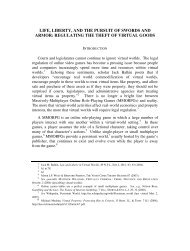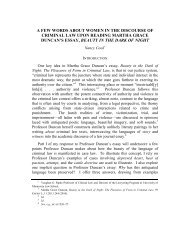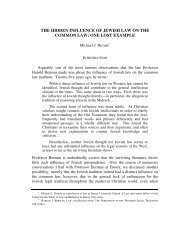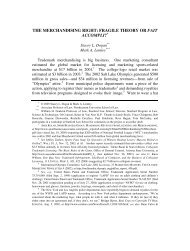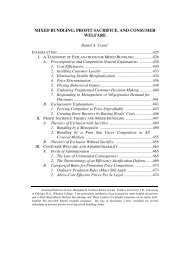Chimera and the Continuum of Humanity - Emory University School ...
Chimera and the Continuum of Humanity - Emory University School ...
Chimera and the Continuum of Humanity - Emory University School ...
You also want an ePaper? Increase the reach of your titles
YUMPU automatically turns print PDFs into web optimized ePapers that Google loves.
374 EMORY LAW JOURNAL [Vol. 55<br />
a being has full moral st<strong>and</strong>ing if <strong>and</strong> only if it is rational. 200 Kant believed<br />
that only humans are rational <strong>and</strong>, <strong>the</strong>refore, rationality was <strong>the</strong> morally<br />
defining characteristic <strong>of</strong> humanity. 201 Animals, which lack <strong>the</strong> capacity to<br />
reason, are thus not morally relevant. 202 The most familiar application <strong>of</strong><br />
Kant’s moral <strong>the</strong>ory is his categorical imperative, which states that a human<br />
should “act in such a way that you always treat humanity, whe<strong>the</strong>r in your own<br />
person or in <strong>the</strong> person <strong>of</strong> any o<strong>the</strong>r, never simply as a means, but always at <strong>the</strong><br />
same time as an end.” 203 According to <strong>the</strong> categorical imperative, <strong>the</strong> killing <strong>of</strong><br />
a human is always morally prohibited, regardless <strong>of</strong> any countervailing<br />
considerations. 204 It is not clear, however, if <strong>and</strong> how Kant’s moral <strong>the</strong>ory<br />
applies to chimera that are part human (<strong>and</strong> thus owed total, inviolable moral<br />
respect) <strong>and</strong> part animal (<strong>and</strong> thus owed none).<br />
Despite numerous attempts over several centuries, no one has established<br />
one fixed set <strong>of</strong> characteristics such as communicative ability or rationality that<br />
includes all humans <strong>and</strong> excludes all nonhuman organisms. 205 Modern<br />
research has demonstrated that animals can communicate, exhibit intelligence,<br />
<strong>and</strong> experience emotion. 206 Some intelligent animals exhibit <strong>the</strong>se traits more<br />
strongly than certain humans, such as <strong>the</strong> very young, <strong>the</strong> severally mentally<br />
h<strong>and</strong>icapped, or <strong>the</strong> comatose. 207 Similar to Justice Stewart’s famous<br />
statement on defining pornography, 208 maybe in <strong>the</strong> era <strong>of</strong> biotechnology we<br />
cannot define humanity, but we know it when we see it. 209 Never<strong>the</strong>less, <strong>the</strong><br />
200 Andrew W. Siegel, The Moral Insignificance <strong>of</strong> Crossing Species Boundaries, AM. J. BIOETHICS,<br />
Summer 2003, at 33, 34.<br />
201 Margaret MacDonald, Natural Rights, in THEORIES OF RIGHTS 21, 28 (Jeremy Waldon ed., 1984) (for<br />
Kant, “[m]en share all o<strong>the</strong>r characteristics with <strong>the</strong> brutes . . . but reason was alike in all men, it was man’s<br />
defining characteristic”).<br />
202 Margit Livingston, Desecrating <strong>the</strong> Ark: Animal Abuse <strong>and</strong> <strong>the</strong> Law’s Role in Prevention, 87 IOWA L.<br />
REV. 1, 15 (2001). Under this view, <strong>the</strong> value <strong>of</strong> any nonhuman things resides only in its value to humans.<br />
Gregory Vlastos, Justice <strong>and</strong> Equality, in THEORIES OF RIGHTS, supra note 201, at 41, 55–56.<br />
203<br />
ROBERT NOZICK, ANARCHY, STATE, AND UTOPIA 32 (1974) (quoting IMMANUEL KANT,<br />
GROUNDWORK OF THE METAPHYSICS OF MORALS 96 (H.J. Paton trans., 1956)).<br />
204 Emanuel Gross, Thwarting Terrorist Acts by Attacking <strong>the</strong> Perpetrators or Their Comm<strong>and</strong>ers as an<br />
Act <strong>of</strong> Self-Defense: Human Rights Versus <strong>the</strong> State’s Duty to Protect Its Citizens, 15 TEMP. INT’L & COMP.<br />
L.J. 195, 230 (2001).<br />
205 Robert & Baylis, supra note 43, at 5.<br />
206 See generally Linden, supra note 196.<br />
207 Robert & Baylis, supra note 43, at 5.<br />
208 Jacobellis v. Ohio, 378 U.S. 184, 197 (1964) (Stewart, J., concurring) (“I shall not today attempt<br />
fur<strong>the</strong>r to define <strong>the</strong> kinds <strong>of</strong> material I underst<strong>and</strong> to be embraced within that shorth<strong>and</strong> description [<strong>of</strong> hardcore<br />
pornography]; <strong>and</strong> perhaps I could never succeed in intelligibly doing so. But I know it when I see it.”).<br />
209 See Robert & Baylis, supra note 43, at 5 (stating that “[w]e all know a human when we see one, but,<br />
really, that is all that is known about our identity as a species”).





